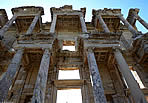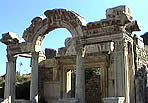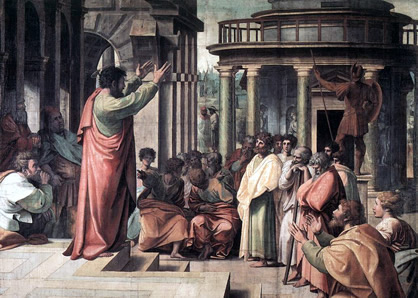Ephesus (Selcuk)
Acts 18:19-24;19:1-35;20:16-17;21:29, I Cor. 15:32; 16:8, I Tim. 1:3
II Tim. 1:18; 4:12, Rev. 1:11,2:1
Introduction:
Historians use terms to describe the ancient city of Ephesus like
the supreme metropolis of Asia which reflects evidence of a highly
developed city. By the time of the New Testament it was a city that
had become a cultural and religious memory, a yesterday romance, not
unlike Paris in the modern world. Filled with the symbols of
greatness, but struggling in the economics of a changing world and a
troublesome silting harbor, the bustling city continued to play a
significant role, but was fading with time.
Location and Population:
Location: Ephesus was constructed on a river bend, that was
eventually dredged into a full harbor near the mouth of the Cayster
River, on the western coast of Asia Minor (modern Turkey). Along the
coastal plain between Smyrna to the north and Miletos to the south,
the site is now about six miles from the Aegean Sea. The city
shifted in five distinct locations over time, each within a small
area. The St. Paul and St. John were familiar with the city that
scholars have dubbed "Ephesus III" the largest (in area) of
the five. The areas where Ephesus located are as follows: Ephesus
I: Ayasuluk (St. John Area); Ephesus II: Artemision area;
Ephesus III: Port of St. Paul: base of Mount Koressos;
Ephesus IV: north of Ayasuluk; Ephesus V: Selcuk area.
Because of the man-made harbor structure and the flow of the river,
a backwash flow caused the harbor to frequently silt up (by 449 BCE
we already read of problems documented about the silting. Later,
Eusebius records that Ephesus honored Emperor Hadrian for dredging
and making navigable the harbor). When cleared, Ephesus was in a
location that justified a great seaport. The city sat at the
convergence of three land routes with a shipping lane from the north
via the c hannel
created by the Island of Chios and an opening facing the cities of
Macedonia. The land routes that converged on Ephesus included: 1)
The Colossae / Laodicea road (traveling east), 2) The road to Sardis
and Galatia (northeast), and 3) The Smyrna (north) main road.
hannel
created by the Island of Chios and an opening facing the cities of
Macedonia. The land routes that converged on Ephesus included: 1)
The Colossae / Laodicea road (traveling east), 2) The road to Sardis
and Galatia (northeast), and 3) The Smyrna (north) main road.
Population: Some scholars estimate the number of people
living at Ephesus to have exceeded 250,000 inhabitants during
Ephesus III, which would make it perhaps the fourth largest of its
day behind: 1) Rome; 2) Alexandria; and 3) Antioch. This large a
city was an economic stronghold in Asia Minor, and justified the
title supreme metropolis of Asia though there is evidence that its
overall economic standing may have been slowly declining.
History of Occupation:
Archaic Period (900-560 BCE): The foundations of the city may date
back to the waves of Sea Peoples and resistance movements that
characterized part of the Archaic Period. A village developed though
it was not as well developed or known as Miletos . It appears to
have played a significant role as part of the Ionian Renaissance
during the time of Heraclitus the philosopher. It was a farming and
trade village until the harbor was established. A significant cultic
site to Cybele developed there.
Cybele: Originally an Astarte-like warrior-goddess associated
with the sacred axe labrys, but later assimilated with the Anatolian
Earth Mother Goddess. Little is known of the cultic wors hip
until much later, when the cult was brought to Rome in 205 BCE. The
later version required the accession of self-emasculated priests
known as galli. Another aspect of the cultic worship was the use of
immersion in the blood of a bull, a practice later taken over by
Mithraism.
hip
until much later, when the cult was brought to Rome in 205 BCE. The
later version required the accession of self-emasculated priests
known as galli. Another aspect of the cultic worship was the use of
immersion in the blood of a bull, a practice later taken over by
Mithraism.
Greco-Lydian Period (560-290 BCE): According to Herodotus
(I.26), King Croessus (560 BCE) conquered the city mid 6th century
BCE, as he tamed the Ionian cities. The establishment of mining
operations for gold and the minting of Lydian coins in this period
gave rise to trade that can be archaeologically documented. During
this period the city re-engineered the Cybele cultic site and built
a Temple to the Greek goddess Artemis, constructed entirely of
marble.
In 546 BCE, the area became part of the Satrapy of Ionia. When
Darius died (485), the Persian Kings son Xerxes focused his
conquest ambition on Greek territory. On a return from battles in
Greece he honored the Temple of Artemis in 478 BCE, an unusual move
as the Persians destroyed many other contemporary shrines. The
Persians were eventually defeated in the region in 466 BCE, when
Ephesus became a tributary of Athens. The city undertook to restore
the Artemision, and the city in 450 BCE.
As the center for tourism and trade, the Artemision became
synonymous with Ephesus . After the tragic fire in 356 BCE
(tradition holds that Herostratos set that temple aflame to make a
name for himself), the city took a long time to recover. Alexander
would later offer to finish the half-reconstructed Temple, but the
city declined, not completing the work until Lysimachus held the
city upon Alexander's death. Lysimachus introduced new colonists and
renamed city after his wif e
Arsino, but name didnt last. He increased the prominence of the
city by enclosing it with six miles of wall. (Today, the traditional
Prison of St. Paul is located within westernmost tower of that
wall).
e
Arsino, but name didnt last. He increased the prominence of the
city by enclosing it with six miles of wall. (Today, the traditional
Prison of St. Paul is located within westernmost tower of that
wall).
Greco-Roman Period (290 BCE-300 CE): After Lysimachus was
killed in 281 BCE, Ephesus came under control of Seleucid dynasty.
They were defeated by the Romans at Magnesia (189 BCE) and Ephesus
was turned over to control by Pergamum , until in 133 BCE Ephesus
came under direct Roman rule.
The site was a known Roman haven, as a discovery of a statue of
Julius Caesar suggests, along with a record that Antony and
Cleopatra wintered there (33/32 BCE). The erection of an Egyptian
style Serapis temple at the northeast corner of the Agora may have
been by Cleopatra. A famous colossal head identified as Antony has
also been found. The Austrian excavation team found a stone head now
universally accepted as that of the Egyptian god Amon. Not always a
period of comfortable relations, Ephesus didnt like Rome initially
when Roman civil wars helped Brutus and Cassius then Antony. Hailed
by Pliny as the great luminary of Asia and by Strabo as the greatest
emporium of Asia, the city enjoyed frequent foreign guests, and
built its tourism industry.
Later emperors also enjoyed a relationship with the city. Statuary
dedicated to Augustus in the temple of Artemis is depicted on
coinage. The monumental triple gate to the commercial agora from the
Library of Celsus was dedicated to Augustus' family in 4/3 BCE.
Augustus also regulated the scope and size of the legal area of
refuge for criminals at the Artemision in hopes of stopping the city
from becoming overloaded with criminals. Later, Nero rebuilt the
stadium and Ephesus coined a commemorative coin in honor of his
work. Nero was not embarrassed to openly take statuary from the city
for his own collection.
Emperor Domitian (81-96 CE the one who exiled St. John to Patmos) is
credited by some as having erected a great altar and temple to
himself on Curetes Street. When Domitian was assassinated in 96, the
colossal statue was destroyed, pieces are found in the Museum at
Izmir. Trajan also took a special interest in the city. His father
had been appointed the proconsul of Asia back in 79 and built a wall
around the Artemision precinct. Trajan added to his father's old
work a new showpiece: the Nymphaion on Curetes street.
After the time of St. Paul and St. John, Emperor Hadrian made
Ephesus his "favorite city" and entitled it the "Imperial Capital of
Asia" (125 CE). He instituted games called Hadrianea and local
sponsors held the games in his honor. A Neocorate temple was built
and dedicated to Hadrian in 129 CE. The citizens of Ephesus honored
Emperor Antonius Pius on his birthday and he built a great gymnasium
in response. The city was eventually destroyed by the Goth invasion
of 262 CE, and it never regained any real importance.
Biblical Sites in Turkey List


